Imagine heading out on a four-star cross-country course with a horse you’ve only ridden for about 20 minutes. In the warm-up, you get the chance to practice his piaffe and passage, do some medium and collected trot, jump a few show jumping fences, and then you get a lead into the start box.
That was my life a few weeks ago when I got an unexpected catch ride on a big black horse named Dante Maximus. So I jammed my heels down, gave this willing horse a kick in exactly the middle of his belly, and we were off. A few times I pulled on the reins too hard, and he came to a dead halt. Another time we did hit a tree—oops, but he was fine. We jumped a two-stride combination from a walk, and I nearly got popped out of the tack jumping down the bank. Still, we made it through the finish flags in one piece!
OK. A (probably obvious) caveat. This was a fake horse—an equine simulator. And I was only “riding him” around a simulated “cross-country course.” Had he been a real horse, well, for starters, none of that would have happened or been recommended, or ahem, even been allowed, but also I probably wouldn’t have been doing any piaffe and passage in the warm-up ring unless it was by accident.
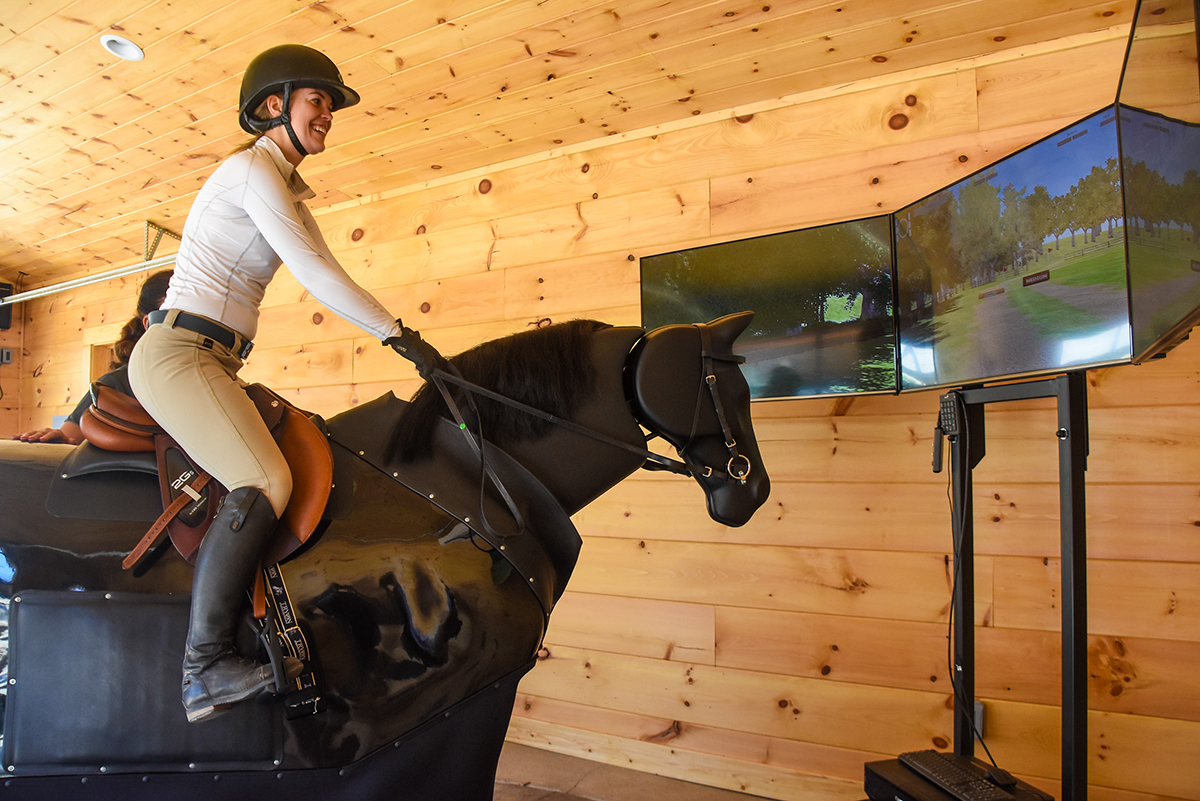
Heading out on course, all smiles, unaware that we were about to hit some trees. Photo by Meg Banks for TIEC
Despite the fact that Dante’s not a real horse, there were parts of the experience that felt pretty real. Waiting for my simulator trainer, Barbro Ask-Upmark, to queue up the “advanced” cross-country program, I did get a little nervous.
It might have had something to do with the fact that when she asked which level cross-country I wanted to try, I said, “advanced!” (because how hard could it be to ride a not-real horse on a not-real course, any course?), and that caused Barbro to furrow her brow in concern. “Are you sure?” she asked. “OK, I’ll hold onto you just in case.”
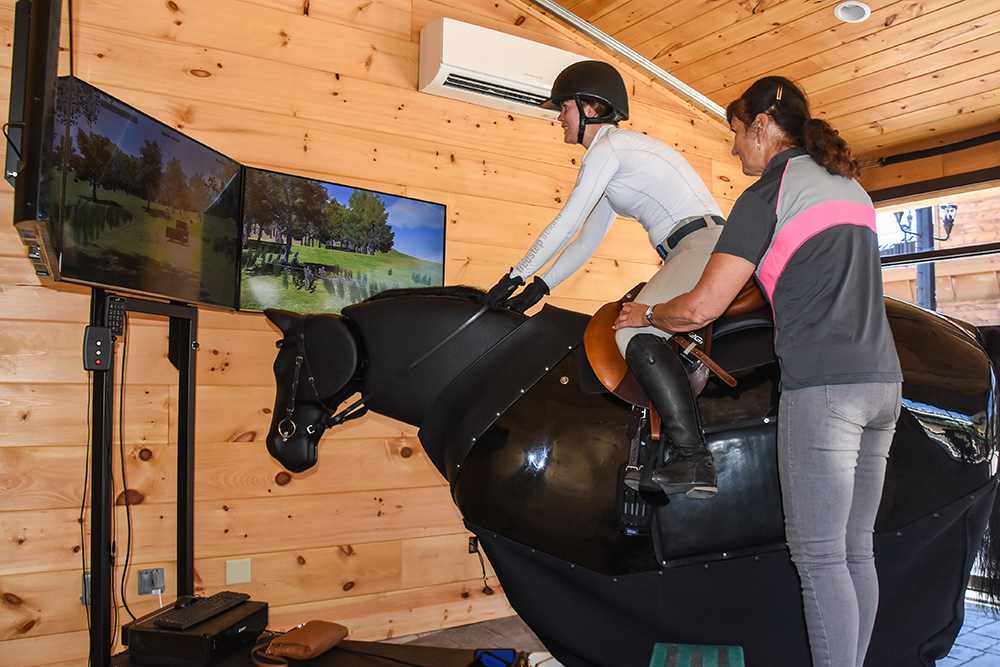
Barbro Ask-Upmark making sure I didn’t fall off over the first fence. Photo by Meg Banks for TIEC
To back up just a bit, Dante Maximus is “stabled” at the Tryon International Equestrian Center in Mill Spring, N.C., where, with the help of Barbro, you can take lessons on him. And yes, while it’s fun to jump old Dante around the biggest jumps on the program, the real benefit of him is of course the educational value he offers.
ADVERTISEMENT
Dante can tell you exactly how crooked you are, how much weight is in your left seatbone versus right, if you pull on your right rein more than your left before, after or during the jumps. He tattles on you if you lean on the neck too much for balance on landing. He actually feels pretty similar to a real horse when jumping, though his trot’s easier to sit than most I’ve ridden. Most beneficially to me, if you apply too heavy a contact without enough leg behind it during jumping, he just halts.
Dante’s an expert at Grand Prix dressage, four-star eventing and grand prix show jumping, and while you do all of the above, a three-part screen in front of you displays your chosen course. At the end of a particular program, there’s a full list of statistics for perusal.
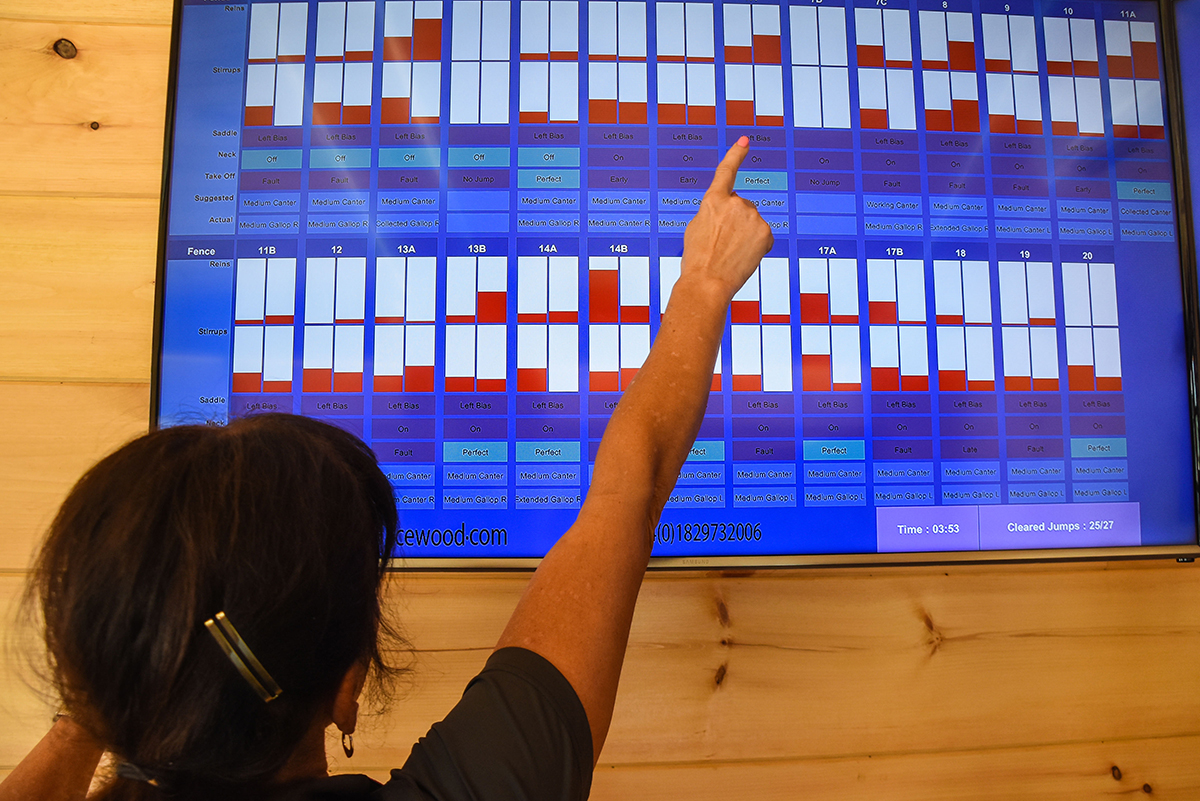
The helpful statistics. Photo by Meg Banks for TIEC
I’ve seen variations on equine simulators before, and some can tell you if you’re equally weighted, but they can’t do much else. My first indication that Dante was different from those was when I was told I needed a helmet to ride him. And breeches and boots. And my gloves.
Yes, you can apparently fall off him. No, I did not.
The morning I left for Tryon, I took a dressage lesson—on my real horse, with my real trainer—and when I told her I was going to ride a simulator, she said, “Oh! Those are the things that make you feel like a terrible rider!” And yep, that was pretty much my experience.
Before I even picked up the reins, Dante told me that I was committing two sins: activating my right leg just sitting still on him and slightly tipping forward. OK, step 1: try to learn to sit on a horse properly. I thought I’d nailed that at 9 but apparently not.
My deficiencies were only further revealed as we got into the program. My elbows don’t move enough, and Dante didn’t like that. (Hey, my real horse doesn’t like that either!) I kept tipping forward. I alternately put too much pressure on with my legs and then too little. I’d take too strong a contact and then forget to keep it once we went to a new gait. I can’t mantain the proper bit-to-elbow line.
ADVERTISEMENT
When we started jumping, he’d shake me loose often, and I’d land in a heap on his neck. I’d be so concerned about our take-off spot for the jump that I’d forget to steer before or after the fence. (Sad to say that does happen in real life. Sorry, real horse.)
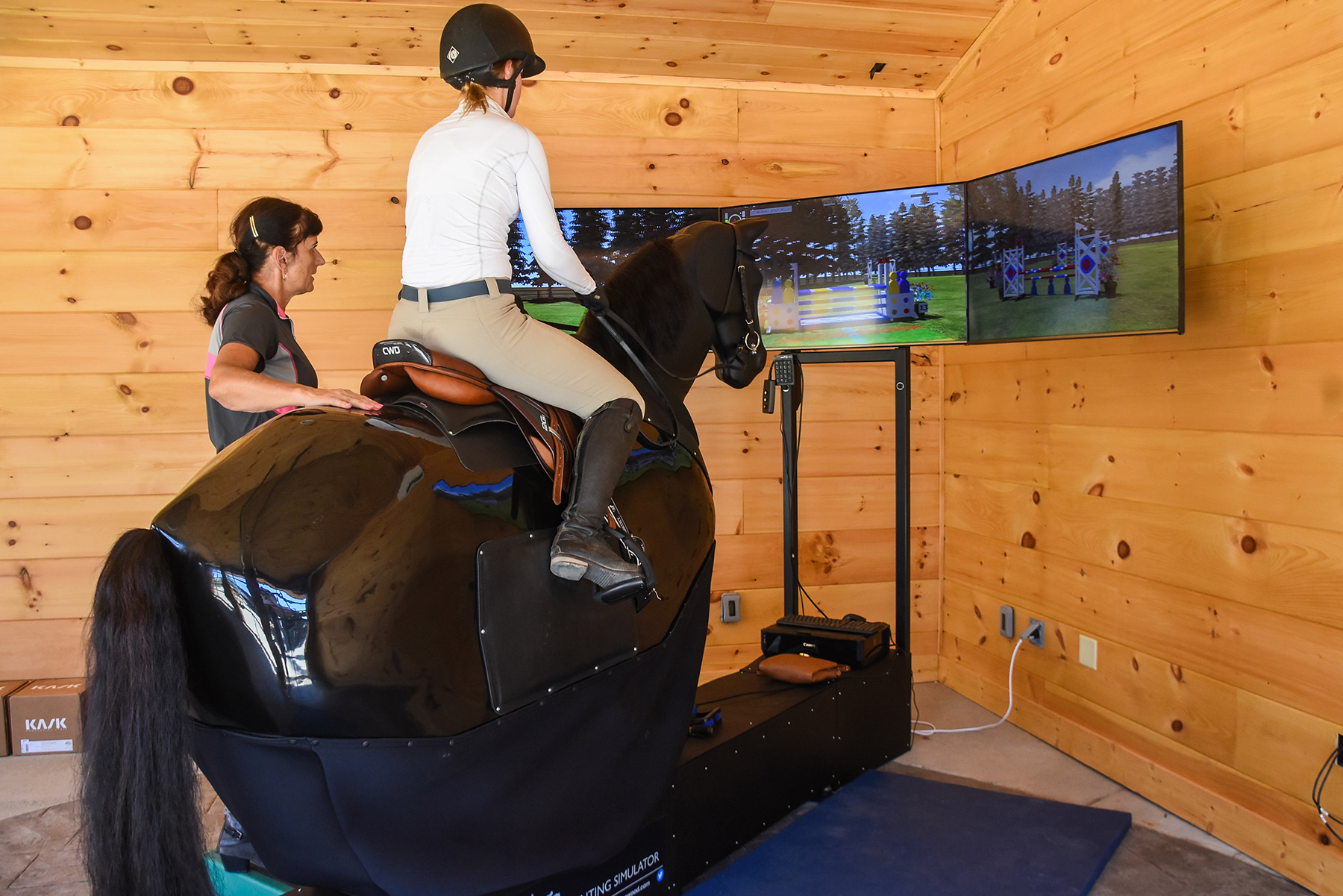
Boy, we are not at all straight to that oxer. BTW Dante doesn’t listen if your leg is in the wrong place, which my right leg clearly is. Photo by Meg Banks for TIEC
When doing advanced dressage movements, I’d accidentally activate his middle sensors instead of his back sensors, and he’d do extended trot instead of piaffe or passage. (I’m not really sure that problem applies as much in the real world—those of you who do piaffe or passage on a regular basis can let me know.)
Dante’s a good dude though, and he doesn’t hold anything against you—even those cross-country jumps we cleared from a halt or walk (would have definitely earned an FEI yellow card for that) or that time we hit a tree. He doesn’t buck or rear. He did kind of extended trot away with me once, but that’s just because I forgot to take my leg off. No matter how badly you ride him, you never undo his training. Which is good, because, as mentioned, you can ride him really very badly.
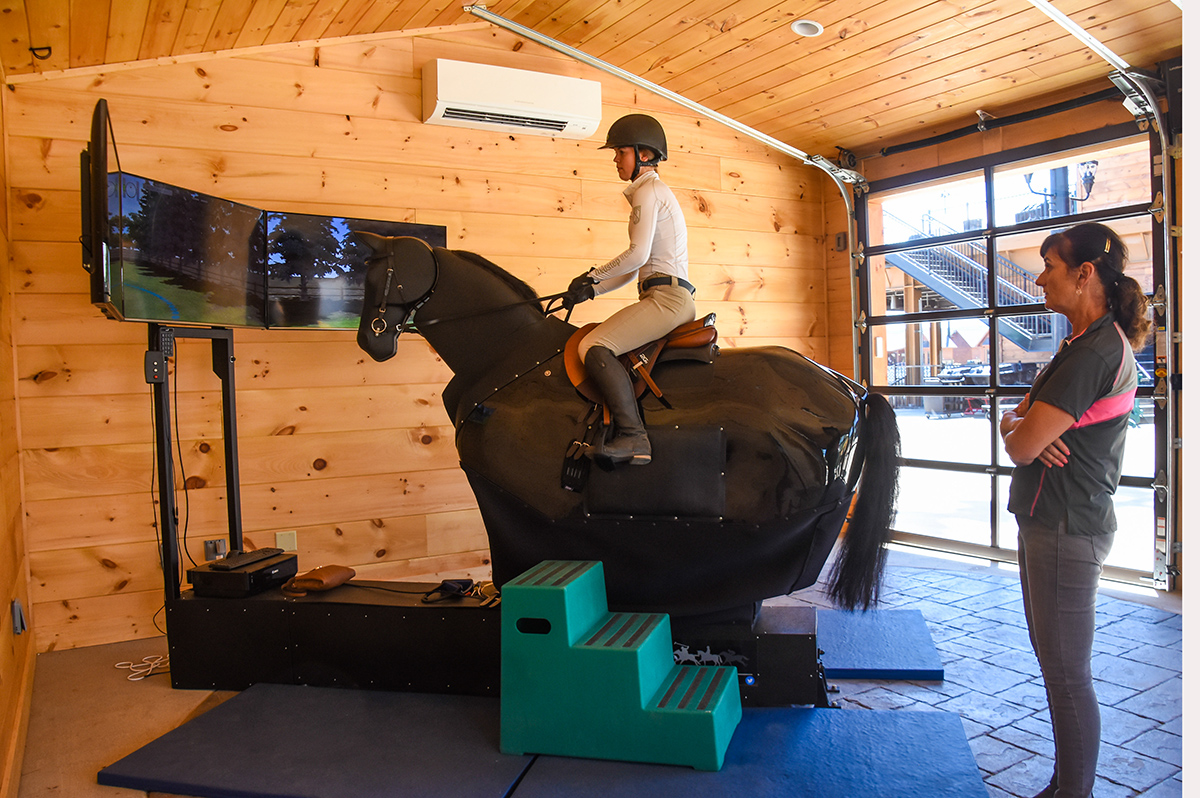
Trying to sit straight. No doubt failing. Photo by Meg Banks for TIEC
But I firmly believe that sometimes feeling a little dumb is just the education you need. (Though, I’m not going to lie, I get that particular education fairly often.) Dante really helps you understand how your weight affects the horse, the slight imbalances you have, that everyone has (I hope?!), and the ways you can help your own horse become more balanced and happier.
And while real horses have an X factor—call it heart, maybe, or at least the self-preservation to mainly avoid trees on cross-country—and an amazing ability to continue trying to understand what you want, Dante is a simple guy. He doesn’t cover for your mistakes and learn to cope with you always pulling a little on the right rein over a jump; that’s just not part of his program. He’s the perfect schoolmaster.
Though Dante might not have heart, or even a heart, poor little Tin Man, of his own, he’s pretty cute and very likable. Even though I knew he didn’t care, I couldn’t stop patting his plastic shoulder when I’d finally ask well enough for him to do the right thing.
If you want to give Dante Maximus a try, you can schedule a lesson with Barbro Ask-Upmark at the Tryon International Equestrian Center or at the Coto de Caza Equestrian Center (Calif.). See the full list of simulator locations at http://alwaysagoodride.com/














